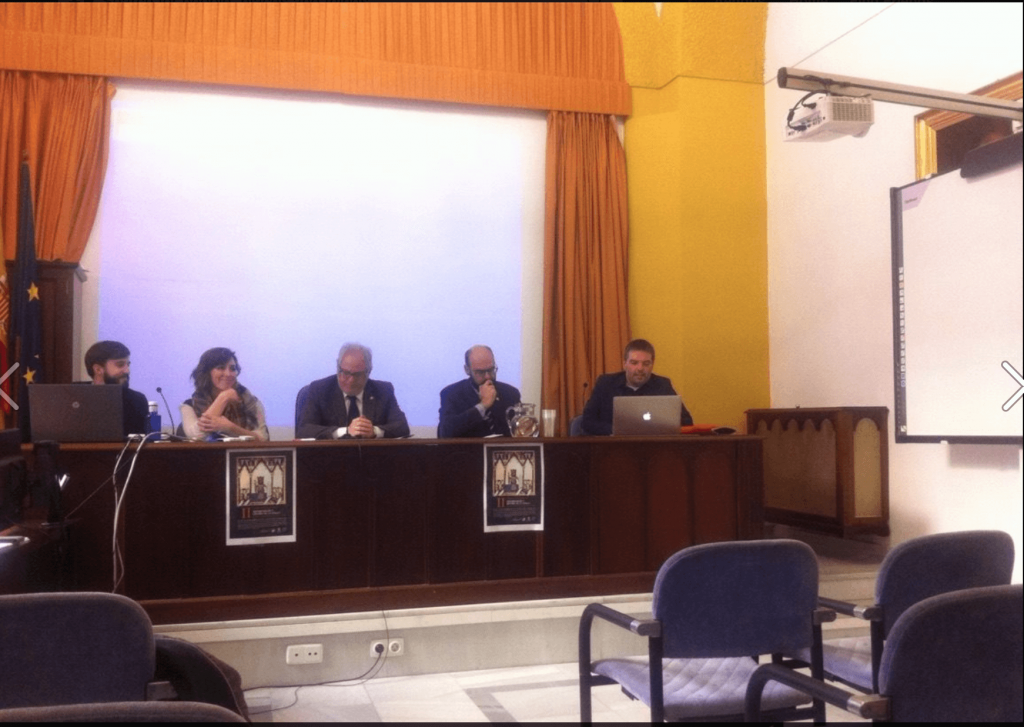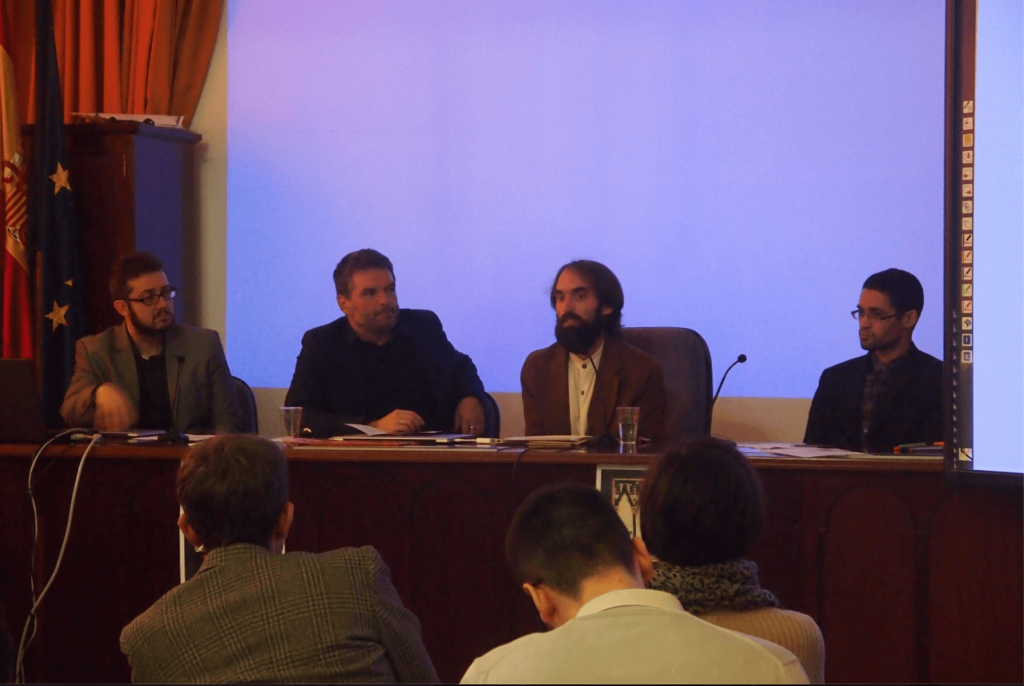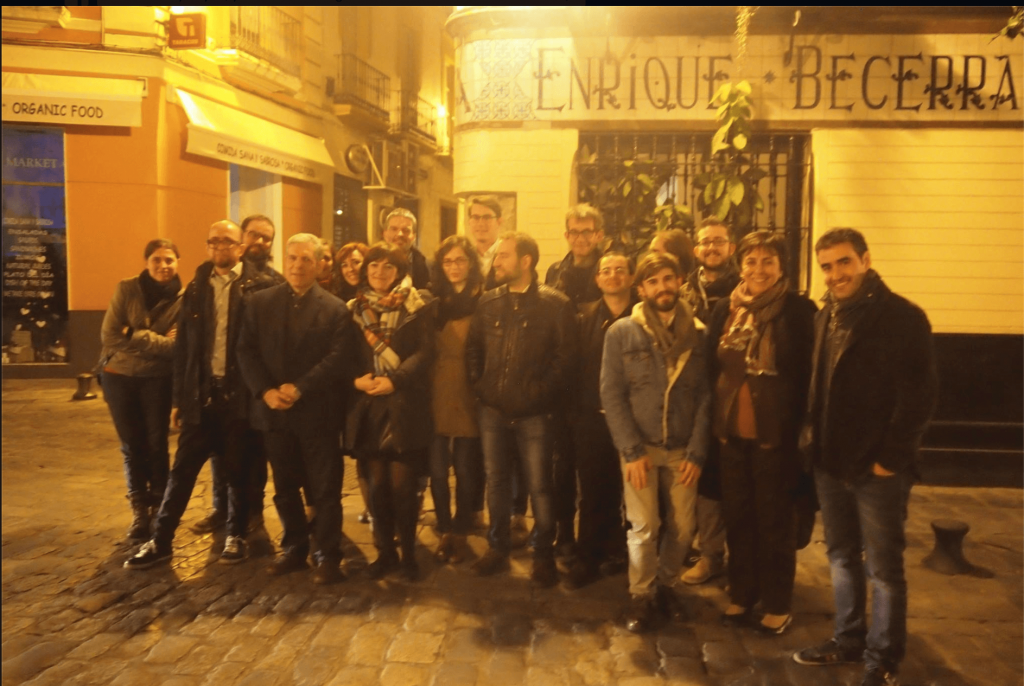Our third colloquium took place at the Universidad de Sevilla in collaboration with our wonderful colleagues from the Historia15 project between the 23rd and 25th of November 2015. It proved to be a marvellous week of intellectual exchange which will live long in the memory.
Day 1 saw the inauguration in the presence of the Dean of the Faculty and the Head of Department from Sevilla. Special mention went out to the leader of Historia15, Lola Pons, who could not be present and also to our friends and colleagues Marine and Virginie who had been closely affected by the massacres in Paris just 10 days before.
The opening day focused on history of the language and provided us with in-depth analysis of Alfonsine language from some big hitters, both young and old, in the field. Rafael Cano Aguilar’s plenary began by offering us an overview of the history of studies of the language of the Estoria. This was followed by Marta López Izquierdo’s detailed study of Alfonsine syntax and Javier Rodríguez Molina’s vast and entertaining review of the dialectal variation in Alfonso’s scriptorium.
The day ended with a tour of Sevilla’s iconic cathedral; a high point was Blanca Garrido’s negotiation with the cathedral guards which permitted us all to (briefly) enter the royal chapel and celebrate Alfonso X’s 794th birthday with him (and indeed Fernando III and Beatriz de Suabia).
Day 2 began with José Luis Montiel taking us back some years to a talk given by Manuel Ariza on the subject of the Cid and historiography, which he brought up to date with more recent research which was followed by Santiago del Rey Quesada’s in-depth study of the processes of textual construction in Alfonso’s works.
The Estoria project’s principal session covered all the bases of the project. First up was Christian on the vision of Muhammad in the Estoria, followed by Enrique’s careful and appropriately contextual account of the foundation of Seville and completed by Ricardo’s outline of his project of a digital edition of the Galician version of the 1289 redaction. A lively debate followed – it seemed as though all of the specialists on historiography had been keeping their powder dry – with Leonardo Funes, Paco Bautista, Manolo Hijano and surprise visitor Marta Lacomba all contributing to a revealing discussion on multiple aspects of Iberian medieval historiography.
The post-lunch session saw the welcome presence of Jorge Ferro – one of three visitors from Buenos Aires – whose characteristically precise talk on the editorial difficulties facing the editors of the López de Ayala chronicles was bookended by Migel Ángel Pousada’s reflections on the advantages and disadvantages of xml in the edition of the Cantigas de Santa María. A fruitful, if exhausting, day was brought to a close by Peter Robinson’s outline of the possibilities of Textual Communities and a live demonstration of the newly-minted collation tool which will be employed in our project.
The third and final day began with a magisterial analysis of the Atarazanas de Sevilla by Pablo Pérez-Mallaína Bueno, which would have resulted in a mass exodus by all present to have a look at the site themselves had it not been for the following talk; a typically entertaining and intellectually detailed account of a previously-lost document of Juan Manuel by José Manuel Fradejas. A stimulating morning session was rounded off by Felipe Moreira’s ground-breaking exploration of the sources and edition of the versión crítica in the reigns of Urraca I and Alfonso VII.
In similar vein, the next session (again with a historiographical focus) saw Nitzaira Delgado-García, Cristina Moya García and Manolo Hijano Villegas discuss the Crónica de Flores y Blancaflor, Diego de Valera and the afterlife of Alfonsine historiography respectively. The post-talk debates ranged from subjects as diverse as the nature of (pre)modern time and detailed questions of textual analysis. Chronicle experts were as one in regarding the discussions as thought-provoking.
The final sessions were introduced by Carmen Moral de Hoyo’s effervescent and incredibly detailed linguistic analysis of dialectal variety in the legislative works of Alfonso and which was matched, in intellectual rigour if not in speed by Kim Bergqvist’s account of Sancho II in post-Alfonsine historiography. The final two papers were also models of their kind: Pablo Saracino, (official photographer of the colloquium whose photos I have added here) gave a philological masterclass on archival research with his detective work on Lorenzo de Padilla and Florián de Ocampo and Leyre Martín Aizpuru, who opened the Oxford colloquium and effectively closed this one demonstrated the methodological effectiveness of which she is a prime example in her account of the alternation between -íe(n) and -ía(n) in Chancellery documents.
Renunirse con los amigos y aprender: along with “A saber” the theme of the colloquium. All present agreed that the intense but fruitful 3 days in Sevilla had fulfilled all expectations. The bar has been set high for Birmingham in December 2016: All are welcome!
Especial thanks go to the Historia15 team, but above all to the wonderful Blanca Garrido Martín and Jaime González Gómez. The welcome offered by all our colleagues in Sevilla will live long in the memory!




